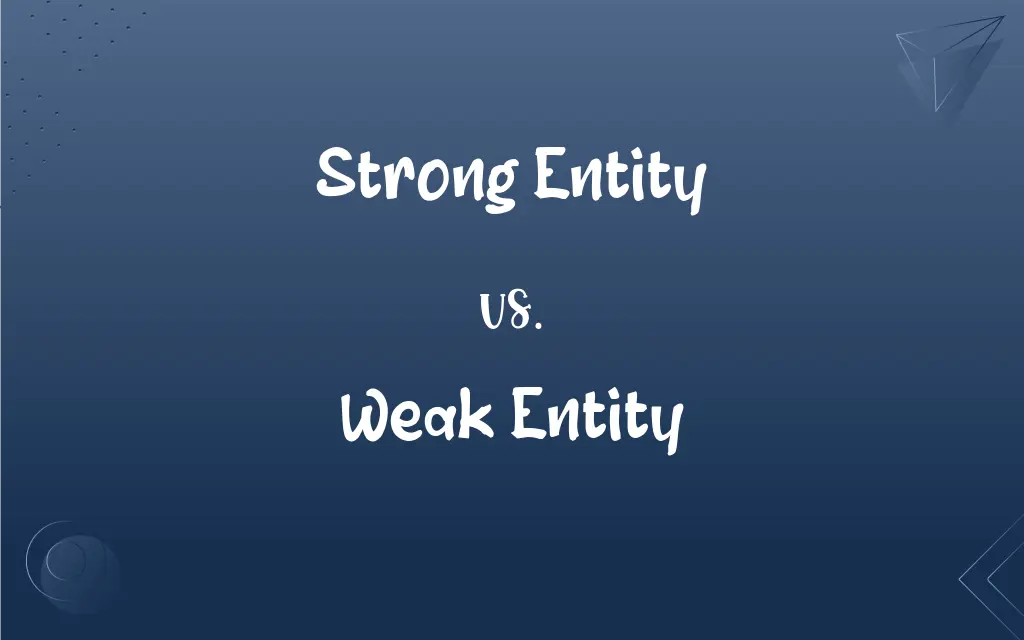Strong Entity vs. Weak Entity: What's the Difference?
Edited by Janet White || By Harlon Moss || Updated on October 26, 2023
A strong entity exists independently, while a weak entity depends on another entity.

Key Differences
In the realm of database design, a strong entity stands as a primary concept. This means the strong entity doesn't require any external information to be understood or identified uniquely. On the other hand, a weak entity is always tied to another entity. Its existence is contingent upon the presence of another, typically a strong entity.
While a strong entity can be distinctly identified by its attributes alone, a weak entity relies on a foreign key in conjunction with its attributes to establish uniqueness. Both concepts are critical in entity-relationship modeling. They allow for a more granular understanding of data relationships and dependencies.
While strong entities maintain their essence autonomously, weak entities perpetually lean on the strong ones, establishing a hierarchal relationship between the two.
Comparison Chart
Existence
Exists independently
Depends on another entity for its existence
Identification
Identified by its own attributes
Identified by foreign key + its own attributes
ADVERTISEMENT
Relationship
Can have relationships with other entities
Always has a relationship with a strong entity
Dependency
Doesn't depend on any other entity
Depends on the parent (strong) entity
Key Attribute
Primary Key
Partial Key + Foreign Key from the strong entity
Strong Entity and Weak Entity Definitions
Strong Entity
A standalone database unit without dependence on another entity for its identification.
A book in a library system is a strong entity with a unique ISBN.
Weak Entity
A unit in a database that depends on another entity for its existence.
In a college database, a course registration is a weak entity dependent on the student entity.
ADVERTISEMENT
Strong Entity
A primary data element that doesn't require external context for identification.
A product in an online store is a strong entity with its own unique product code.
Weak Entity
An entity that cannot be uniquely identified without an associated primary key of another entity.
A transaction record is a weak entity tied to a specific account.
Strong Entity
An element in an entity-relationship model that can be distinctly identified by its attributes.
In a hospital database, a patient is a strong entity with a unique patient ID.
Weak Entity
An entity lacking its unique key attribute.
In a theater database, seat reservations are weak entities dependent on the specific showtime.
Strong Entity
A unit in a database that exists independently.
In a database, a student is a strong entity identified by their unique student ID.
Weak Entity
A subsidiary database element with its identification relying on a stronger entity.
In an airline system, ticket details are weak entities tied to a particular flight booking.
Strong Entity
An entity having its unique key attribute.
A bank account is a strong entity identifiable by its account number.
Weak Entity
A data element that requires external context or another entity to be fully understood.
The chapters in a book are weak entities dependent on the book itself.
FAQs
How does a weak entity differ from a strong entity?
While a strong entity exists on its own, a weak entity depends on another entity for its existence.
Is a weak entity always associated with a strong entity?
Yes, a weak entity always has a relationship with a strong entity.
Can a strong entity exist without a weak entity?
Yes, a strong entity can exist independently without any associated weak entity.
Can a weak entity exist by itself in a database?
No, a weak entity always depends on a strong entity for its existence.
What kind of key does a strong entity typically have?
A strong entity typically has a primary key.
Are there performance implications in using weak entities in a database?
Yes, weak entities can introduce additional joins and complexities which might impact performance.
Can a strong entity be identified by its attributes?
Yes, a strong entity can be distinctly identified by its own attributes.
How is a weak entity typically represented in an ER diagram?
In an ER diagram, a weak entity is typically represented by a double rectangle.
Can a database have multiple weak entities associated with a single strong entity?
Yes, one strong entity can be associated with multiple weak entities.
What happens to a weak entity if its associated strong entity is deleted?
If a strong entity is deleted, its associated weak entities usually become meaningless or get deleted too.
What's a strong entity?
A strong entity is a primary unit in a database that exists independently.
Why is a weak entity important in database design?
Weak entities represent dependent data elements and help in capturing more granular relationships in data.
Is every entity in a database either strong or weak?
Yes, in the context of ER modeling, entities are typically categorized as either strong or weak.
Do weak entities always need foreign keys?
Yes, weak entities use foreign keys to relate to their parent strong entity.
Why not just use strong entities everywhere?
Weak entities allow for more precise modeling of real-world relationships and data dependencies.
Does a weak entity have its own primary key?
No, a weak entity is identified using a foreign key combined with its own attributes.
Can there be relationships between two strong entities?
Yes, two strong entities can have relationships between them.
Are strong entities more significant than weak entities?
Not necessarily. The distinction is about independence, not importance.
Can a weak entity become a strong entity?
Conceptually, if a weak entity gains attributes that allow it to be identified independently, it can be considered a strong entity.
Is the concept of strong and weak entities exclusive to relational databases?
No, the concept is primarily associated with ER modeling but can be applied in various data modeling contexts.
About Author
Written by
Harlon MossHarlon is a seasoned quality moderator and accomplished content writer for Difference Wiki. An alumnus of the prestigious University of California, he earned his degree in Computer Science. Leveraging his academic background, Harlon brings a meticulous and informed perspective to his work, ensuring content accuracy and excellence.
Edited by
Janet WhiteJanet White has been an esteemed writer and blogger for Difference Wiki. Holding a Master's degree in Science and Medical Journalism from the prestigious Boston University, she has consistently demonstrated her expertise and passion for her field. When she's not immersed in her work, Janet relishes her time exercising, delving into a good book, and cherishing moments with friends and family.
































































